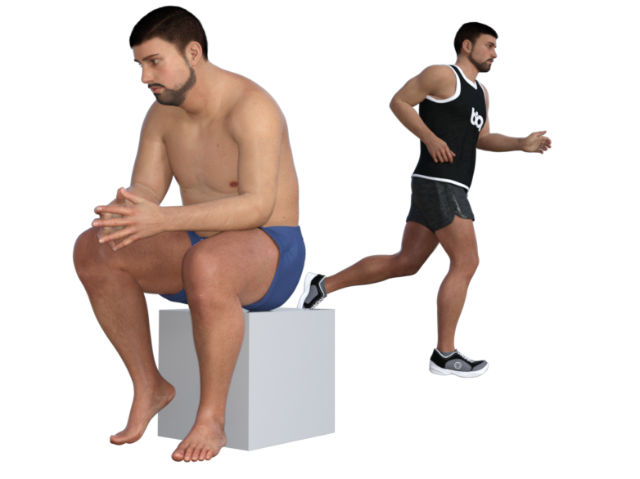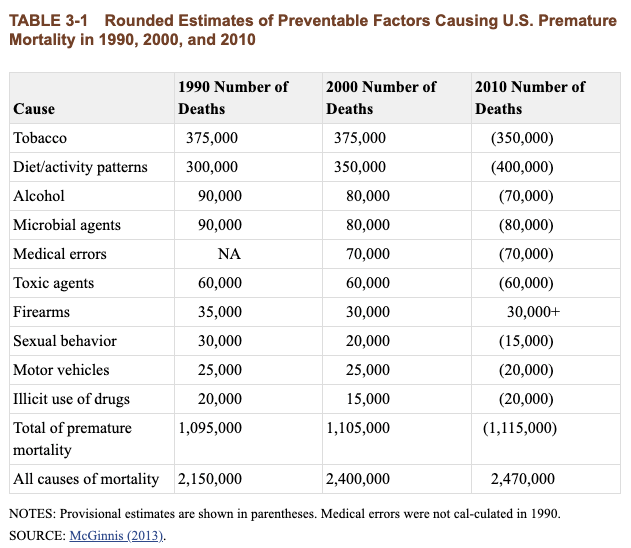Finding Common Ground
A good discussion increases the dimensions of everyone who takes part.
~ Randolph Bourne
I expect that certain ideas and facts presented in this book will go against some widely accepted conventions or, perhaps, even your personal beliefs. And that's fine; everything you read here is open for discussion. After all, "getting the conversation going" is one of the primary goals of my writing. I think we all can, however, establish common ground by agreeing that the sedentary nature of modern life has a tremendous negative impact on pretty much all of us.

Inactivity has become one of the most prevalent causes of premature deaths in the US. It is a contributing factor to many surging modern diseases, including hypertension, type 2 diabetes, obesity, and cardiovascular disorders.
At the same time, over 80% of the active adult population is involved in sedentary occupations. This means that, by simply doing our jobs and providing for our families, most of us become exposed to the risks associated with inactivity. This has a detrimental effect on our health and our well-being, which, consequently, affects our lifespan and quality of life.

Inactivity and Kids
Another critical point that I would like to emphasize is that, for quite some time now, we have been observing the evolving sedentary tendencies associated with school- and college-age students. As a result, our youngsters have been affected by inactivity much earlier than previous generations. It is painful to accept that young adults and kids are susceptible to diseases previously common only to much older population groups. These diseases start affecting our kids at early ages, significantly limiting their lives’ potentials.
That is pretty sad. But, even more sad is the fact that it is a self-inflicted problem, entirely avoidable. Or, in other words, this is a problem that should not exist. Yet, according to CDC, we attribute around 8% of death cases to inadequate levels of physical activity (cdc.gov), which translated to approximately 235,000 premature deaths in 2018 in the US alone.

It might seem like this problem has a seemingly simple solution: "don't sit as much, and move more." In fact, a lot of recommendations are based on this very idea, including the official Guidelines for Physical Activity by the US Department of Health and Human Services. I believe, however, that trivializing this issue with such a flippant recommendation is rather shortsighted and a bit disrespectful. Let me explain why.
Defining the Context
As I mentioned, currently, there are two widely accepted recommendations:
- Sit less
- Move more (exercise)
The problem with the first one is that many people will interpret "sit less" to mean "swap sitting for standing." Although it may seem like a logical choice, you will soon find out that it may not be an adequate substitute, and must be approached with caution. (We will discuss this more in later chapters.)
For others, "sitting less" may not be an option – professional drivers, for instance – unless they make a drastic change in their lives or career choices. By recommending sitting less, we are not offering a solution, but instead, we are preaching avoidance. It would be similar to suggesting getting into an empty swimming pool to avoid drowning. It partially addresses our concerns, but it doesn't really make sense if your goal was to swim, right?
Just to set the context right, we are not looking to avoid sitting. Our goal is to find a way to do it safely. I believe that sitting, if done responsibly, has its place and purpose (read Why We Sit). Besides, chairs are not modern inventions, existing for centuries. So, let's not blame them for our modern problems.
As for "move more," we have known for quite some time now that periodical exercising – in the conventional sense that comes to our mind when we hear the word – is not as effective in alleviating issues associated with chronic inactivity as was once believed. Therefore, it is simply not true to claim that going to the gym a few times a week will be sufficient at getting you off the hook. Yet, this strategy is still widely accepted and promoted. That happens for a few reasons, but mostly because the health and fitness industries are quite inert when it comes to innovations, and have their own commerce-oriented agendas, which are not always aligned with the public's best interests.
The Approach
You will not hear me say "Sit less." Sitting is not going away, so we must learn to deal with it. Consider this to be one of the essential survival skills for modern life that everyone has to master.
For that purpose, we will take a close look at what happens when we sit. We will identify how sitting can affect us and our health, as well as using our discoveries to develop an effective and sustainable strategy.
The latter is of particular importance because I believe it doesn't matter if you have an ideal plan unless this plan ideally fits into your lifestyle. We will also discuss other economic considerations, such as scheduling and frequency of exercising, debunking many myths imposed on us by unfounded, outdated conventions. (Spoiler alert! We don't need to work out as much as you may think.)
Another thing, I won't tell you to sign up for a gym membership. As a matter of fact, I hope you never go back to the gym to work out again. Now, I should clarify: I’m not saying you will not exercise, or that you won't look fit. I just think there is a better way – a more effective and efficient way – to exercise, packed with many additional benefits. It's called fragmented exercising.
Fragmented Exercising
Fragmented exercising is a simple idea, but it's a new paradigm that may be hard to accept at first. I envision, however, that it won't take long for it to become the norm.
Who would have imagined that yoga pants would become such a common, anytime-anywhere attire? You may or may not enjoy this fashion trend, but I think it goes beyond just matters of comfort and appearance. To me, it seems like a natural evolution of the social acceptance of the "fitness anywhere" movement. And fragmented exercising will take it even further.
I know it could be seen as somewhat silly to bring up women's leggings while discussing this burgeoning approach to exercise, but, when we talk about the role of social acceptance in the formation of conventions, you will understand what I mean. At some point, something may look or sound weird, seeming to be out of context. Soon, however, it becomes the norm. Once again, mark my words: you will see fragmented exercising everywhere. Just like yoga pants.
So, then, what is fragmented exercising?
It's simple! It involves breaking up our slightly modified exercise routines into smaller fragments (hence, “fragmented”) and spreading them somewhat evenly throughout the day. This approach has quite a few advantages over the conventional approach to exercising.
Advantages of fragmented exercising
- It's easier to fit in a few smaller exercise sessions (2-to-5 minutes) throughout the day than it is to find a whole hour for one long workout;
- Not only will you address your fitness aspirations, you can also help your body remain in an active state that will keep all its systems functioning optimally at all times;
- "Boosting" your cardiovascular system with regular, quick muscle pumps will positively affect your energy and productivity levels via the improved and consistent delivery of oxygen and other nutrients;
- Simply taking breaks will relieve your passive and active musculoskeletal structures of the stresses accumulated from static sitting and repetitive tasks. Take it further with neuro-facilitated resets, and avoid long-term postural adaptations that lead to chronic back and neck pains, joint aches, carpal tunnel syndrome, sciatica, etc. Think of it as a form of fragmented yoga, but much more effective;
- Improve your metabolical functions and weight regulation by stimulating non-exercise activity thermogenesis (NEAT);
- And many others.
Frankly put, I want you to transcend the traditional notion of exercising because there is no such thing as a workout in nature. Periodical physical exercising – one hour every other day or even every day – is our pathetic attempt to offset the damages we cause to ourselves by being inactive. Fragmented exercising aligns us with the natural activity pattern of continuous or perpetual movement, which is essential for maintaining good health and function. It helps to keep our internal systems awake from "sedentary hibernation."
Sedentary hibernation is a term I'm introducing to encapsulate the idea of various short-term adaptations and systemic down-regulations in response to prolonged sitting, which puts our body in a special hibernation-like (or barely-functioning) mode. Avoiding this mode is one of the main goals of fragmented exercising and continuous movement. (More on sedentary hibernation)
In the next section, we will start our discussion of the problems we face as a sedentary society. We will also mention the failing conventional approaches, as well as their shortcomings and ineffectiveness in addressing these issues. I hope that it will help you to part ways with many preconceived ideas about fitness and wellness, opening your mind to accepting more practical and effective alternatives.